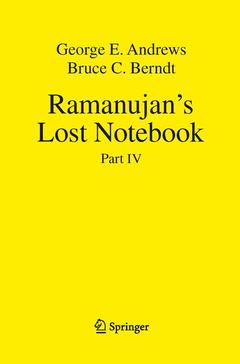Description
Ramanujan's Lost Notebook, 2013
Part IV
Authors: Andrews George E., Berndt Bruce C.
Language: English
Keywords
Bessel Functions; Euler's constant; Fourier transforms; Guinand's Formula; Koshliakov's Formula; Mellin transforms; circle and divisor problems; classical analysis; classical analytic number theory; diophantine approximation; divisor sums; gamma function; hypergeometric functions; prime number theorem; transformation formulas; trigonometric series
158.24 €
Subject to availability at the publisher.
Add to cartSupport: Print on demand
158.24 €
Subject to availability at the publisher.
Add to cart439 p. · 15.5x23.5 cm · Hardback
Description
/li>Contents
/li>Biography
/li>Comment
/li>
????In the spring of 1976, George Andrews of Pennsylvania State University visited the library at Trinity College, Cambridge, to examine the papers of the late G.N. Watson. Among these papers, Andrews discovered a sheaf of 138 pages in the handwriting of Srinivasa Ramanujan. This manuscript was soon designated, "Ramanujan's lost notebook." Its discovery has frequently been deemed the mathematical equivalent of finding Beethoven's tenth symphony.
This volume is the fourth of five volumes that the authors plan to write on Ramanujan?s lost notebook.? In contrast to the first three books on Ramanujan's Lost Notebook, the fourth book does not focus on q-series. Most of the entries examined in this volume fall under the purviews of number theory and classical analysis. Several incomplete manuscripts of Ramanujan published by Narosa with the lost notebook are discussed. Three of the partial manuscripts are on diophantine approximation, and others are in classical Fourier analysisand prime number theory. Most of the entries in number theory fall under the umbrella of classical analytic number theory. Perhaps the most intriguing entries are connected with the classical, unsolved circle and divisor problems.
Review from the second volume:
"Fans of Ramanujan's mathematics are sure to be delighted by this book. While some of the content is taken directly from published papers, most chapters contain new material and some previously published proofs have been improved. Many entries are just begging for further study and will undoubtedly be inspiring research for decades to come. The next installment in this series is eagerly awaited."
- MathSciNet
Review from the first volume:
"Andrews and Berndt are to be congratulated on the job they are doing. This is the first step...on the way to an understanding of the work of the genius Ramanujan. It should act as an inspiration to future generations of mathematicians to tackle a job that willnever be complete."
- Gazette of the Australian Mathematical Society?
Preface.- 1 Introduction.- 2 Double Series of Bessel Functions and the Circle and Divisor Problems.- 3 Koshliakov's Formula and Guinand's Formula.- 4 Theorems Featuring the Gamma Function.- 5 Hypergeometric Series.- 6 Euler's Constant.- 7 Problems in Diophantine Approximation.- 8 Number Theory.- 9 Divisor Sums.- 10 Identities Related to the Riemann Zeta Function and Periodic Zeta Functions.- 11 Two Partial Unpublished Manuscripts on Sums Involving Primes.- 12 Infinite Series.- 13 A Partial Manuscript on Fourier and Laplace Transforms.- 14 Integral Analogues of Theta Functions adn Gauss Sums.- 15 Functional Equations for Products of Mellin Transforms.- 16 Infinite Products.- 17 A Preliminary Version of Ramanujan's Paper, On the Integral ∫_0^x tan^(-1)t)/t dt.- 18 A Partial Manuscript Connected with Ramanujan's Paper, Some Definite Integrals.- 19 Miscellaneous Results in Analysis.- 20 Elementary Results.- 21 A Strange, Enigmatic Partial Manuscript.- Location Guide.- Provenance.- References.- Index.
These books may interest you

Ramanujan's Lost NotebookPart III 147.69 €

Ramanujan's Lost NotebookPart III 147.69 €

Ramanujan's Lost NotebookPart V 137.14 €

